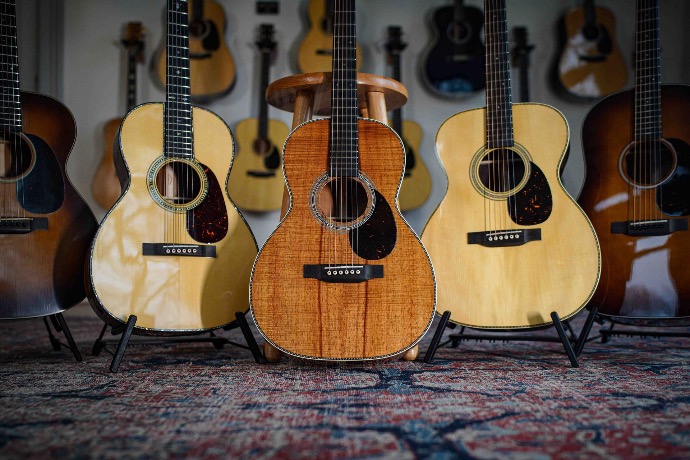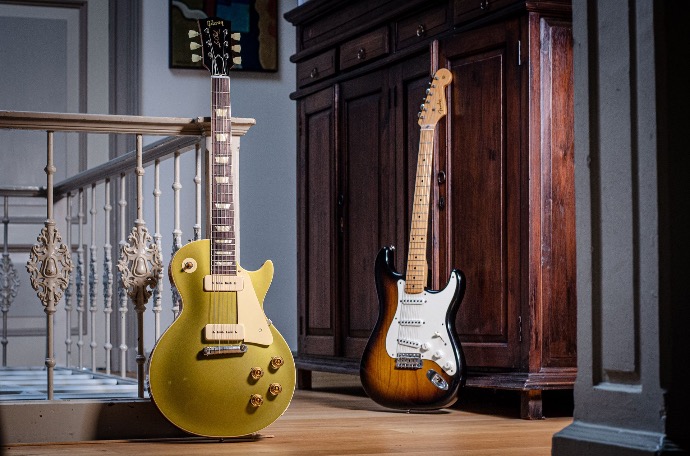Tuning is part of playing guitar, but how often you have to tune varies greatly. If you play a guitar for a while, the strings can stretch a bit and then you just have to tune again. If a guitar hangs on the wall or if you walk with it from one room to another, or if you take a guitar out of the suitcase; it all affects the temperature and the humidity. Wood can therefore shrink or expand a bit and that also means tuning.
A tuner is the easiest way to do this and they come in all sorts of sizes and prices, starting at just 12 euros so you this should not keep you from getting one.
But even with a tuner you might sometimes get the feeling that you keep turning those tuners endlessly and your guitar does not respond as you expect. Then it may be worthwhile to check the following:

STRINGS
Choose the right strings!
If strings stay on a guitar for too long, they start to sound flat, loose some of their tension and do not stay in tune very well. How often you have to replace strings depends -among other things- on how much you play, how much you sweat and how well you clean the strings after you have played. Some professional guitarists change after each performance. Do you play every day? After a month, the best of what strings have to offer is probably gone. Are you in doubt about the quality of your strings? Just try a new set, most guitars will improve greatly.
Guitars are tuned to a certain type (thickness or gauge) of strings. It is OK to deviate, but for the best tuning it is good to take these preferred strings into account. Are you unsure about which strings best suit your guitar? Luthiers usually have that on their website and we also have that knowledge in-house. Feel free to contact us by mail, chat or phone.
More about strings and replacing strings.
Have your strings replaced at TFOA
Are the strings put on properly?

Functie drie
Verwijder de bovenstaande afbeelding of vervang ze door een afbeelding die je bericht illustreert. Klik op de afbeelding om stijl van de afgeronden hoeken te wijzigen.

Functie drie
Verwijder de bovenstaande afbeelding of vervang ze door een afbeelding die je bericht illustreert. Klik op de afbeelding om stijl van de afgeronden hoeken te wijzigen.

Not like this:
But more like this:
Not like this either:
Stretch the strings
New strings still have quite a bit of stretch in them, so whether you put new strings on an acoustic or electric guitar, with or without a tremolo: you have to stretch them. You do not have to pull on them roughly, but certainly not too soft either. Let's just call it ‘firm’. A very young Guitar Grandmaster Tommy Emmanuel, explains how to do this on one of his instructional DVDs :
THE GUITAR
You have tuned with a tuner, there is a fresh set of strings on it, they are put on the right way and they are properly stretched and yet the tuning still trails. Then it's time to take a closer look at the guitar itself.
Is the nut correct?
Start with the nut, an often forgotten and important part of the guitar, because on that transition from fretboard to tuners, the strings must 'roll' smoothly. Maybe you know that sound you hear when you are tuning your guitar, you twist the tuners, and (almost) nothing happens, until you hear a soft 'ding'? That may indicate that the strings are a bit stuck in the nut. Could be some dirt, so cleaning and a little lubrication with graphite might help and if that does not do the trick, maybe the nut needs to be adjusted and that is something that is best done by a professional. The Fellows in our workshop are happy to help you.
Tuners?
In the workshop we regularly see tuners that have come loose. They can start to rattle, so just check and tighten the nut that holds the tuner in place. Sometimes a tuner bumps into something, making them crooked and that does not help the tuning of your guitar, so replacing it, is a good idea.
Nothing sharp?
Sometimes on the bridge, tremolo or on a tuner, there are small, sharp edges: burlaps. These can cause strings to break earlier and especially the G-string appears to be vulnerable . Easy to solve with a file or a bit of sanding paper, so you can give it a try yourself, but our advice is: ask a professional to make sure what you are getting into before going at your guitar yourself with any tools.
Bridge &Tremolo
With acoustic guitars, the bridge is glued to the body and it sometimes comes loose, so that is something to check in case of tuning problems. Also check if bridge pins are neatly aligned.
Do you have an electric guitar with a tremolo? Then that requires some extra attention, because the tremolo 'floats' on the bridge and the suspension system must ensure that the strings come back into position. This requires adjusting of the spring tension, which works together with the thickness of the strings. You can of course put other strings on your guitar, but the tension may differ and that means you also have to adjust the springs. You can of course have that done by a pro, but you can also try it yourself:
Intonatie
That brings us to the last point of attention: intonation. A guitar is not a perfect instrument where the notes fall exactly in the spaces between the frets on the neck. That has to do with complicated proportions and mathematics, which means that you have to adjust things a bit to get a guitar as ‘intonated’ as purely as possible. With a well-intonated guitar, a loose string has the same pitch as the one you play on the 12th fret.
If the intonation is not correct, you will notice this especially if you play chords higher on the neck. With an electric guitar you have a more options to adjust the intonation yourself, with an acoustic guitar it is a bit more complicated and we advise you to have that included in a set up.
THE PLAYER
The guitar is tuned, the strings are OK and the intonation is spot on... but when you start playing it just doesn't sound good. Well, if it's not the gear, then there's only one option left: the player.
Of beter gezegd: de spullen en de speler zijn dan nog geen perfecte match. Dat gebeurt best vaak, bijvoorbeeld bij een gitarist die jarenlang op een akoestische dreadnought heeft gespeeld met dikke .013 snaren, overstapt naar een elektrische gitaar met 0.10 of nog dunnere .09 snaren. De kans is groot dat je dan de elektrische gitaar een beetje ‘overspeelt’ en net even iets te hard duwt en trekt, waardoor wat voorheen goed klonk, er nu net naast zit. Bij de overstap van staal naar nylon kan zoiets ook gebeuren. Onze Fellows in de winkel en in de werkplaats helpen je graag bij de zoektocht naar de juiste materialen die passen bij jouw speelstijl én met tips voor jouw speelstijl zodat jij met jouw gitaar de stemming er straks weer goed in weet te brengen. De koffie staat klaar!

